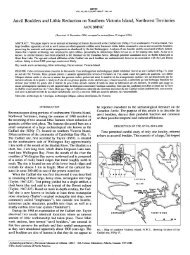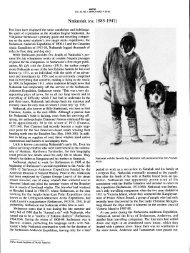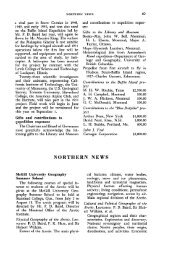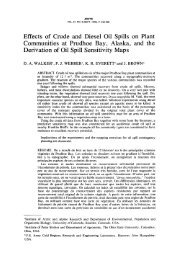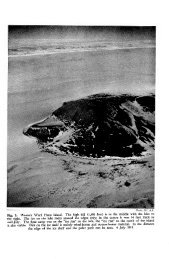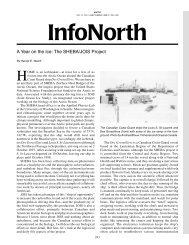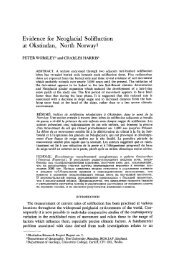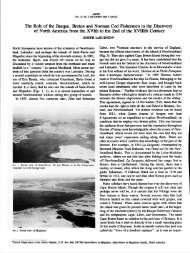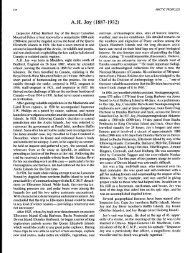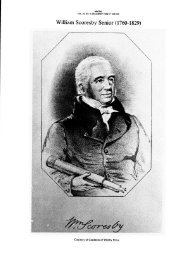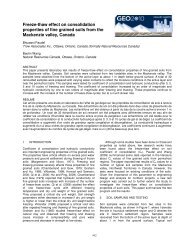NOTES ON THE NUNAMIUT ESKIMO AND MAMMALS OF ... - arctic
NOTES ON THE NUNAMIUT ESKIMO AND MAMMALS OF ... - arctic
NOTES ON THE NUNAMIUT ESKIMO AND MAMMALS OF ... - arctic
Create successful ePaper yourself
Turn your PDF publications into a flip-book with our unique Google optimized e-Paper software.
‘<strong>THE</strong> <strong>NUNAMIUT</strong> <strong>ESKIMO</strong> <strong>AND</strong> <strong>MAMMALS</strong> <strong>OF</strong> <strong>THE</strong> ANAKTUVUK PASS REGI<strong>ON</strong> 15 3<br />
Fig. 6. Springs at the south end of Tulugak Lake, late May 1919.<br />
dominant species here are Cassiope tetragona (L.), Ledum palustre var. decumbens<br />
Ait., Rhododendron lapponicum (L.) Wahlenb., Empetrum nigrum L., and Vacciniuwz<br />
Vitis-idaea L.<br />
The river and creek banks are covered by heavy stands of willow, including,<br />
among others, Salix alaxensis Cov., S. Richardsonii Hook., S. arbusculoides Ands.,<br />
and S. <strong>arctic</strong>a Pall., with a varied undergrowth of Equisetum spp., mosses, and<br />
lichens. Birch-willow communities of Salix spp. and Betula nana L., with undergrowths<br />
of mosses and lichens, occur in drier habitats.<br />
The dry, rocky mountain slopes support little vegetation other than Dryas<br />
octopetala L., which also occurs on moraines and alluvial fans. South-facing slopes<br />
are covered with Dryas, with other species interspersed, while the north slopes<br />
support a Cassiope-lichen community, in which Cladonia spp. are important.<br />
Therofon Richardsonii (Hook.) is a very common plant of moist drainage areas,<br />
usually associated with various mosses. The higher peaks are barren.<br />
Solifluction terraces in the mountains support a dense growth of vegetation. In<br />
such places occur Salix spp., Dryas octopetala, Potentilla biflora Willd., Poa glauca<br />
Vahl, P. pratensis L., Carex scirpoidea Michx., C. Bigelowii, Kobresia simpliciuscula<br />
(Wahlenb.), and Polygonum viviparum L., among others. Earth-surface movements,<br />
which are important in the region, have been discussed by Troll (1944).<br />
Sedge-bogs are found in and around semi-permanent shallow pools of water in<br />
favourable places at altitudes to about 3,000 feet. Characteristic plants are Equisetum<br />
pratense Ehrh., E. variegatum Schleich., Carex aquatilis, C. membranacea Hook., and<br />
Eriophorum angustifolium Honckeny.<br />
In some areas the lower hillsides are covered by tussock (“niggerhead”) tundra,<br />
the predominant plant being Eriophorum vaginatum spissum (Fern.). Local, often<br />
pure, stands of various plant species occur, including Alnus crispa, and Populus<br />
tacawuhacca Mill., none of which is large enough to be important.<br />
Mosses form an important part of the plant community in almost every habitat.<br />
Rhytidium rugosum (Hedw.) (ivrok, “roof moss”) grows around marshy areas, in



